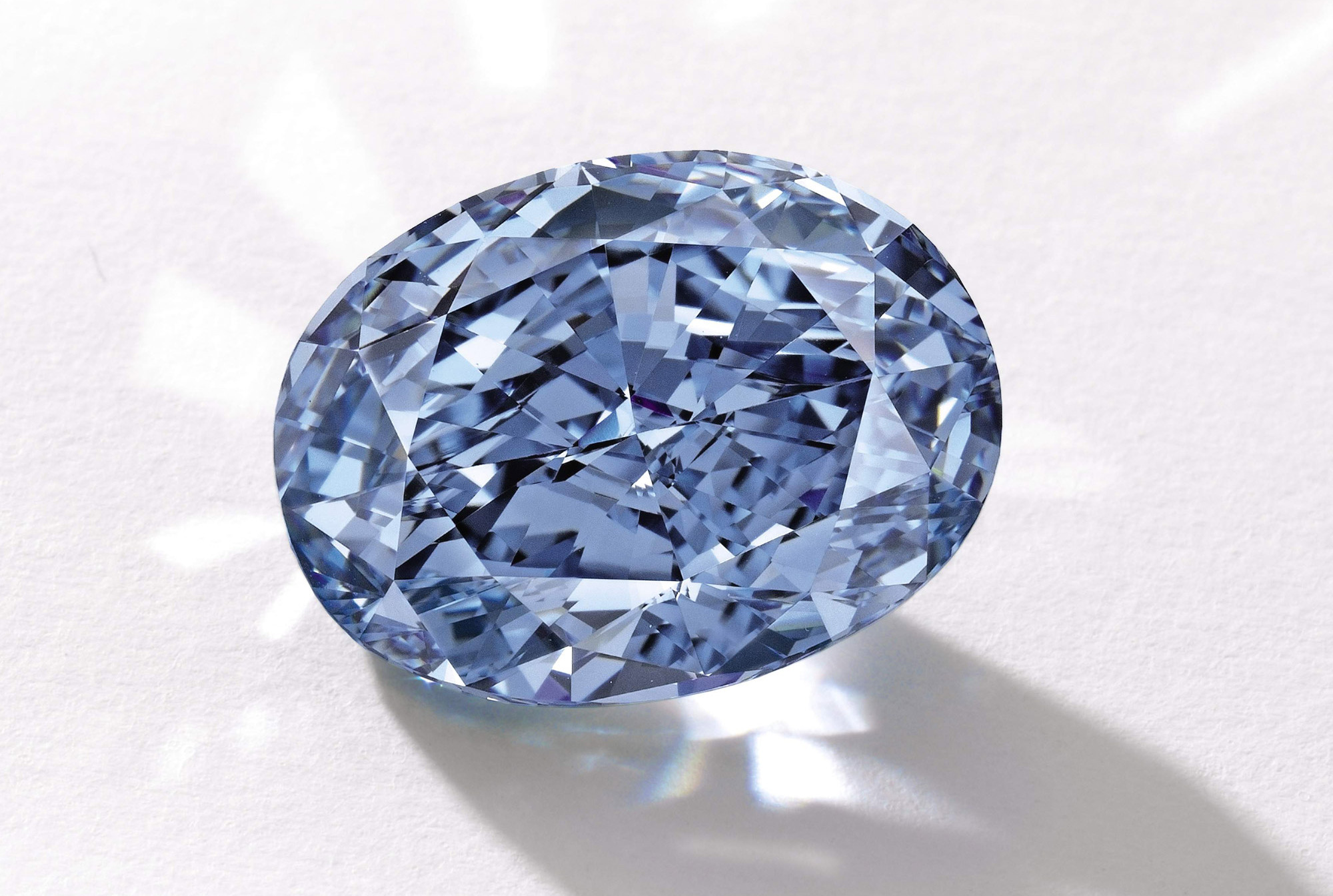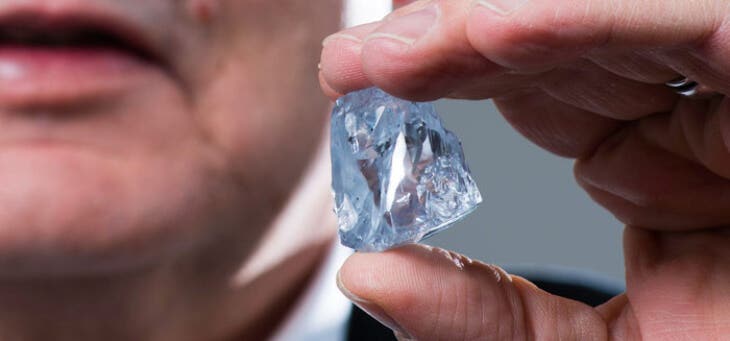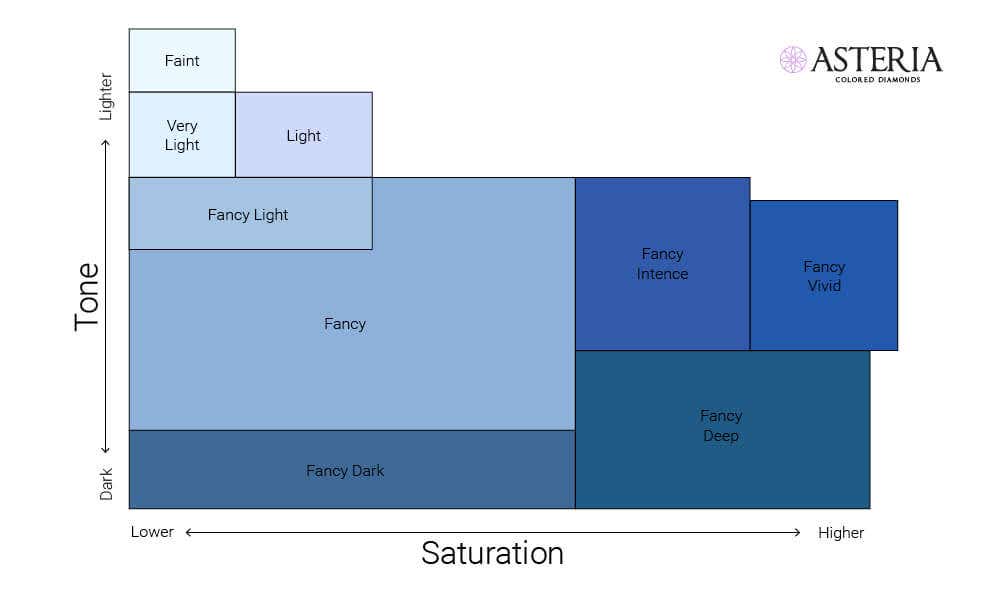Natural Blue Diamond: Prices, investments, engagement rings & more | Asteria Colored Diamonds
Natura Blue Diamonds are among the rarest and most expensive fancy colored diamonds, in dwindling supply and increasing demand. Blue diamonds prices rise every year in record-breaking increments and in the last decade, in addition to being mysterious and beautiful gems, blue diamonds have become popular among investors and collectors who want to own these natural wonders as well as capitalize on them.
Discover with us the secrets of the natural blue diamond: How is it formed? Where is it quarried? What is the price per carat and how is it graded? All this and more, in this article.
What Is Blue Diamond?
Like other fancy colored diamonds, the blue diamonds' color is a result of impurities that occur during the diamonds’ natural creation process. The blue color emerges from the interaction of boron molecules within the structure of the pure carbon crystal. As a result, the diamond absorbs yellow light and reflects blue light. The concentration of boron molecules in the diamond directly impacts the tone and saturation of the blue hues, ranging from the mesmerizing blue color of soft sky hues to deep and mysterious ocean shades.
Are natural blue diamonds rare?
In the diamond world, there is a common saying that most jewelry designers never encounter natural blue diamonds throughout their lives. Its message is loud and clear - natural blue diamonds are very rare, even for those who work in the profession.
The rarity of natural blue diamonds compared to the other natural diamonds in the market is undisputed. Indeed, of the 12-14 million carats of diamonds polished annually, only a meager 0.01% of them will be fancy colored diamonds, and about 80% of that tiny fraction are yellow or brown diamonds with a high percentage of gray or black diamonds as well. Blue diamonds, along with pink, red, orange, purple and green diamonds are considered the rarest and most sought after in the world. Some might say the demand for these diamonds is inversely proportional to their number in the market, and the rarer they get, the higher the demand for them.
To illustrate - according to the NCDIA, only 2 to 4 major blue diamonds are released to the market every year, and since 1999 only 50 Fancy blue Vivid diamonds have been sold at auctions around the world. That is a very small number, especially compared to the thousands of white diamonds sold every year, for decades now.
Natural blue diamonds prices & investment opportunities
In the diamond world, the highest value which all collectors and investors look up to, that which creates competition and ultimately leads to extreme rises in prices - is rarity, which we discussed in the previous section.
The price of a Fancy light blue diamond weighing 1.07 carats in 1999 was $22,600 per carat at an auction at Christie's in New York, compared with a Fancy light blue diamond weighing 5.06 carats sold at the same auction house for a total of $286,000 per carat (more than 12 times the last price) in 2016. Blue diamonds weighing 3 carats and up with higher saturation, such as a Fancy intense blue and above, come at an astronomical price of one million dollars and up per carat.
The high rarity of blue diamonds and their skyrocketing prices make them very popular, especially among collectors and diamond investors, who in addition to their desire to own these remarkable creations, can enjoy their constant increase in value over the years and turn it into profit.
The impact of this fact is evident in the blue diamonds prices in the past decade, which have been rising annually by 12% -17%, while in the first quarter of 2016 they showed the highest increase among any group of natural fancy colored diamonds. Of course, within the blue diamond category, the extremely rare Deep and Vivid hues showed the highest price increase due to their rarity and stunning color.
Natural Loose Blue Diamonds value by the 4c's
The pricing of diamonds, be it fancy colored or colorless ones, is based on four key parameters known as the 4 C's - Color, Carat, Clarity and Cut. Like any other fancy colored diamonds whose rarity is determined by the color category they belong to, the prices of blue diamonds too are affected primarily by their color.
Fancy Natural Blue Diamonds: COLOR EXPLAINED
As mentioned, the color blue is considered the rarest in the world of fancy colored diamonds, and this fact influences the price range to which it belongs. A diamond’s color is officially determined by professional gemological institutes, led by the Gemological institute of America (GIA), which perform meticulous tests using advanced technological equipment to examine the color of the diamond according to three main parameters: Hue, Tone and Saturation. At the end of the process, the color definition will be listed in the diamond’s official certificate of authenticity, which also lists additional features that we will discuss later. The certificate gives you the peace of mind to make a safe purchase of the right diamond for you. It is strongly advised to insist on getting one.
The parameters affecting the fancy blue color definition:
Hue - represents the diamond’s primary and dominant color, blue in this case. This value will be specified in the official certificate, sometimes alone and sometimes together with one or two secondary hues found to a lesser extent in the diamond. In the case of multiple colors, the primary hue will appear last. (see further detailed explanation of secondary hues in blue diamonds later in this article).
Tone - represents the penetration of light into the fancy colored diamond and its effect on the primary hue. The levels of tone are divided as follows - Very light, Light, Medium light, Medium, Medium dark, Dark, Very dark. Blue diamonds reach the highest saturation level in medium to dark tones.
Saturation - represents the color’s strength and intensity. The stronger and more vivid the color, the rarer the diamond. And the price goes up accordingly. The intensity range of blue diamonds is relatively narrow compared to other fancy colored diamonds, while the tone range is relatively wide.
These three parameters together comprise the color definition according to the GIA, as listed in the certificate.
Blue Diamonds for sale - By Astteria
You are welcome to explore the Natural Blue Diamonds GIA certified offered for sale by Astteria >
Color grading of blue diamonds
The color grading of the world's leading Gemological Institute, the GIA, is divided into 9 color intensities: Faint blue, Very light blue, Light blue, Fancy light blue, Fancy blue, Fancy intense blue, Fancy Vivid blue, Fancy deep blue and Fancy dark blue; with Faint blue representing a bright and pastel hue and Fancy deep blue representing a strong deep blue hue.
In addition to this color grading, there are some other labels for the various hues of blue, including: Baby blue, Royal blue, Navy blue and Midnight blue.
The effect of secondary hues on the pricing of blue diamonds
Secondary hues are in fact impurities that occur in the diamond to a more limited extent compared to the primary hue that determines the diamond’s color, and are subsequently called overtones or modifying colors. Sometimes the diamond may even have two secondary hues. The effect of modifying colors on the diamond’s color definition is evident in that the hue is written near the dominant color in the certificate: The first rule is that the primary hue is always listed last after the secondary hues. The second rule is that the overtones are listed in a way that reflects their dominance. For example: Greenish indicates the presence of a relatively low concentration of green color, whereas Green indicates a higher dominance, though still not as high as the primary hue.
Natural loose blue diamonds often come with secondary hues, and the price of the diamond is dictated by the rarity of the overtone compared to the primary hue. For example, a secondary gray hue will reduce the price of a blue diamond because of its relative abundance compared to the rare blue color, while a rare and valued hue such as violet will raise the price.
Secondary hues found in natural blue diamonds: green, gray, violet.

All blue diamonds' secondary hues as in photo - From left to right
Line 1: faint blue diamond, fancy light blue diamond, fancy vivid blue diamond, fancy light greenish blue diamond, fancy green blue diamond, fancy greenish blue diamond, fancy blue diamond,
Line 2: light blue diamond, fancy blue diamond, fancy intense blue, fancy deep blue diamond, fancy gray blue diamond, fancy light greenish blue diamond, fancy vivid blue diamond
Line 3: , fancy vivid blue diamond, fancy intense blue diamond, fancy grayish blue diamond, light blue diamond, fancy deep blue diamond, fancy grayish blue diamond, fancy dark blue diamond
Natural Loose Blue Diamonds Prices By Carat, Clarity & Cut
So far, we’ve explained how the first C, diamond’s blue COLOR, is the main factor influencing the pricing and how its exceptional rarity significantly raises the price. But along with this key fact, there are three other key parameters you should study and understand before choosing the right blue diamond for you - the three remaining C's: Carat, Clarity and Cut.
Carat - The price per carat of a blue diamond is firstly affected by its color - the more intense it is, the higher the price per carat - and secondly by its weight - the more carats of blue diamond, the higher the price per carat.
Blue diamonds above 3 carats are already considered very rare and their price per-carat are rising significantly.
* Keep in mind that “Carat” does not represent size, but rather weight, while the Cut is the parameter that affects the diamond’s appearance and size.
Clarity - Although diamonds are usually small and glittering stones whose flaws, if any exist, are not visible to the human eye, the clarity scales set by gemological institutes such as the GIA, specify the diamonds’ level of internal clarity when magnified 10,000 times.
A diamond’s clarity level indicates the stone’s quality, the level of penetration of light, from the reflection and the stone’s shine.
The clarity rating is represented in a scale that includes 9 grades divided into 6 groups:
FL - Flawless
IF - Internally flawless
VVS1 & VVS2 - Very, very slightly included
VS1 & VS2 - Very slightly included
SI1 & SI2 - Slightly included
I1 & I2 – Included
Cut - some confuse “Cut” with the diamond’s shape, but actually the cut refers to the sensitive and broader task that begins on the table of the polisher, who professionally identifies the best way to approach the diamond so that the cut will flatter its natural features, compliment its color, maximize its sparkle and make it look bigger than its weight.
Although the quality of the cut is not a crucial parameter like the diamond’s color or carat in terms of pricing, but even a normal human eye can tell the difference between an excellent cut and a poor one.
Although it’s not really necessary to have a perfect cut since our human eyes will not notice the smallest flaws, don’t settle for a poor cut that doesn’t emphasize the diamond’s color, or is asymmetric or lacks shine, as then it would be a poor investment in a rare and expensive stone that doesn’t reach its full potential.
A good cut will do the job and give you excellent value for your money.
Natural blue diamonds vs. treated blue diamonds
The exceptional rarity and high price of these wonderful gems has led to a huge and unsatisfied demand for natural blue diamonds, which the market cannot meet. As a result, a niche of treated blue diamonds has emerged. Prepared in laboratory conditions, these diamonds attempt to imitate the natural blue diamonds and provide a cheaper artificial solution for the unmet demand.
Treated blue diamonds are in fact white diamonds sent to the lab to undergo a chemical process or HPHT (High Pressure High Temperature) process in order to create pressure so great that the color of the diamond’s shell artificially changes to blue while its interior remains white.
If you insist on getting a rare and natural blue diamond, make sure it has a certificate of authenticity issued by a recognized gemological institute (preferably the GIA) or get one issued immediately upon receipt to confirm that the diamond’s declared values match the test results.
In the certificate of authenticity issued to you, after the diamond’s color definition you will find the “Origin” section. If the stone was created naturally, it will say – “Natural”.
Where are natural blue Diamond quarried?
Most blue diamond are quarried from one major mine in Cullinan, South Africa, owned by Petra Diamonds, which over the years has managed to bring to the market many of the most famous blue diamonds.
Other active mines digging up blue diamonds are the Golkonda mine in India and the Lesteng mine in Lesotho, South Africa.
Natural Blue Diamond Engagement Ring
In addition to everything we’ve told you so far about the rarity of natural blue diamonds, and beyond their breathtaking beauty and soaring value, there is a spiritual-psychological significance that instills even more charm and uniqueness into this diamond and gives you even more reasons to choose it as an engagement ring for your beloved.
The color blue represents truth, honesty and confidence. Those are the most prominent energies it radiates, and it is also the perfect color to embed in the engagement ring for your chosen one, your true love, your best friend and the warm and caring home and family you will build together.
In addition, blue is the color of spirituality, intuition, inner peace and inspiration. If your special darling has these traits, it would be a perfect gesture of love to match her engagement ring with a blue diamond that complements the rarity and perfection of your love for her, as a daily reminder of the eternal honor and respect you have for her.
Have any questions about blue diamonds? Write us a comment or contact us and we will be happy to answer them!
Want to consult with a specialist about purchasing a blue diamond? Click here.












